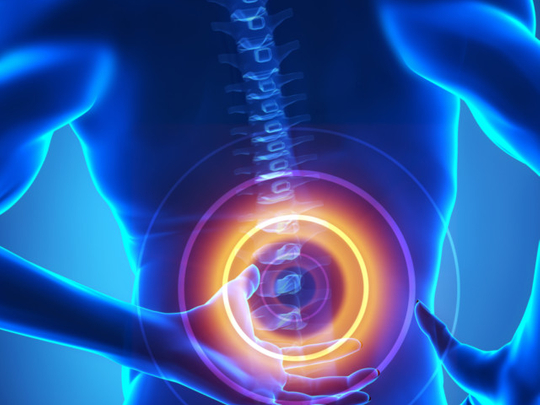
According to numerous research reports, almost 80 per cent of all adults will suffer from back pain at some stage in their life. The overwhelming variety of reasons includes natural causes, as well as self-inflicted and inherited conditions: poor posture, lack of exercise, wrong/heavy exercise, prolonged sitting, injury, obesity, abnormality, medical conditions, disease and degeneration.
As a part of the body under constant stress, the spine is extremely prone to disorder, and spine-related ailments are among the most common in the world, including infections, injuries, irritation of nerves, muscular strain, tumours, bone changes, disc damage, and debilitating conditions such as arthritis, scoliosis and spondylitis. Further, pain can originate from bones, joints, facets, ligaments, muscles, nerves, intervertebral discs and paravertebral tissues.
With so many potential sources and causes of pain, correct identification can be a confounding problem for the patient, and often for doctors too.
Lack of empathy
Although back pain is a common complaint, much of the suffering seems to be done in stoic silence. Acute back pain is an abrupt and intense pain that subsides after a period of days or weeks. It typically resolves with rest, exercise, and other self-care measures. Chronic pain lasts longer, and may continue in spite of treatment.
“No one understands what I undergo every day,” says Irene John, an Indian resident of Dubai, who was identified with facet arthropathy and spondylolysis six years ago, but only sees a doctor when the pain drives her to complete inactivity.
“Mine is a degenerative condition and I have now developed a lifestyle around protecting my back, and preventing pain. I regret not having seen a doctor when the problem first manifested itself, and it is now too late for any repair work,” she explains.
The backbone, or spine, comprises 33 bone discs called vertebrae including the five that are fused to form the sacrum, and four coccygeal bones that form the tailbone. The spinal column combines strong bones, unique joints, flexible ligaments and tendons, large muscles and highly sensitive nerves, which allow standing and bending, support the entire upper body, and protect the spinal cord.
A major cause for chronic pain among working adults and the most common cause for referral to a hospital is osteoarthritis, or degenerative spine disease. Although a normal part of aging, and therefore common among older patients, strains on the back can cause it in much younger people too. The most common examples of degenerative spine disease are herniated discs, spinal stenosis and spinal instability.
Any injury to the spinal column, spinal cord or spinal tissue is referred to as spine trauma, as are indirect injuries to other parts of the body that place pressure on the spine. While trauma to bones and ligaments only cause pain, injuries that affect the spinal cord can cause nerve-related problems such as paralysis, loss of feeling and involuntary movement.
Spinal tumours can be located in the spinal cord, the spinal canal’s dural covering, or on adjoining soft tissue or bone. Spinal dysraphisms are spinal cord or vertebral column abnormalities, and involve errors in how the spine grows, either by natural, deliberate or accidental causes. Dysraphisms include spina bifida occulta, meningocele, myelomeningocele, and syringomyelia.
Professional help
Visiting a doctor is the next stage. “The most common ailments I have seen in the UAE are lower back pain, neck pain, shoulder pain, headaches and radiculopathy, or numbness and tingling in either the arms or legs. >
“While the severity differs from case to case these can all be debilitating, and decrease the quality of living. It is important to get it checked out if you are suffering from any of these disorders,” says Dr Tod Cahill, an Atlas Orthogonist at the Atlas Spinal Center in Dubai.
The Mayfield Clinic of Cincinnati in Ohio, USA, is recognised as a global leader in neurological surgery, and has treated hundreds of thousands of patients since its establishment in 1937. “Of the many types of specialists who treat spine problems, each has specific skills and plays an important role in patient care. The right specialist to treat your condition depends on the type and severity of the problem,” they advise. (See box for details)
Overcoming back pain may seem like a daunting task, but avoiding it involves small, simple steps. “Major trauma can be the cause of spinal misalignment but more often than not, it is the daily repetition of bad posture that eventually leads to symptoms,” says Dr Cahill.
“Poor posture while sitting, and improper repetitive motions are the root of many issues. Sleeping on the stomach can also cause spinal misalignment, and eventual symptomology. These misalignments are not caused by an occasional bad posture but repetitive continuous acts that can accumulate over time.”
Researchers at King’s College London have identified a gene linked to age-related degeneration of the intervertebral discs in the spine, promising hope to millions who suffer lower back pain. The genetic cause of lumbar disc degeneration (LDD) has remained unknown until the largest study to date — published two weeks ago in Annals of Rheumatic Diseases — revealed an association with the PARK2 gene.
According to Dr Frances Williams, Senior Lecturer at King’s College’s Twin Research and Genetic Epidemiology, “Further work by disc researchers to define the role of this gene will shed light on one of the most important causes of lower back pain. If we can build on this finding and improve our knowledge of the condition, we may one day be able to develop new, more effective treatments for back pain.”
Although pain is no laughing matter, laughter is a cheap cure. The Move to Improve event hosted by the Emirates Arthritis Association demonstrated laughter exercises to overcome arthritis. Sahar Moussly, author, Master Behavioural Coach and laughter wellness teacher, says, “Arthritis patients suffer from discomfort, pain, stiffness or fatigue. However, laughter wellness exercises can minimise its overall effects on their everyday lives, and has proven to be the best medicine without any side effects.”
— Special to GN Focus










